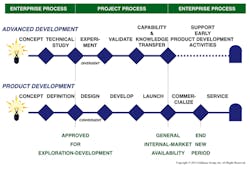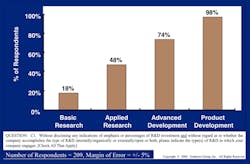Only a few industries — such as pharmaceutical, biotech, chemical, and semiconductor — have routinely and necessarily focused on underserved markets instead of underserved customers. These industries operate on the philosophy of “build it and they will come.” As such, they have invested in the preproduct development activities of basic research, applied research, and advanced development to a much larger extent.
Of course, companies are more interested in profits than in the self-esteem of their engineers and product developers. So after the tech boom, market-leading companies increased investments and formalized their advanced processes. Now, a decade later, that process is beginning to permeate just about all industries. Advanced development is the current rage, and it will eventually lead to more applied research.
What is advanced development? Well, there are several definitions. Some companies use it to turn out finished designs that go right to manufacturing. Others have it wrestle down hard-to-achieve features and commercialize unfamiliar or unpredictable technologies. And some companies also throw stretch products into advanced development to get them to the marketplace. No one knows the best definition yet.
Advanced development is now practiced by three-quarters of all companies to some degree. New research will soon update this figure. AD strategy is a large subject, but its workflow should be analogous to product development. Recognizing that AD engineers will have consultative roles, the goal of AD resources should be to release commercialization-ready capabilities, technologies, features, and functions to portfolio managers and product developers. Necessarily, some AD will trace back to customer and market requests while some will be leveraged to build something truly innovative, and the customers will come. As best practices sort themselves out, AD is sure to be an exciting place for its engineering and technical professionals.
Bradford L. Goldense, NPDP, CMfgE, CPIM, CCP, president of Goldense Group Inc. (GGI), has advised over 300 manufacturing companies in product management, R&D, engineering, product development, and metrics on four continents. GGI is a consulting, market research, and executive education firm founded in 1986.
Subsequent writings in this column will expand on the lessons-learned of where
we have been, and will offer views on what the future holds for product design.
About the Author
Bradford Goldense
Contributing Technical Expert
Bradford L. Goldense is founder and president of Goldense Group, Inc. [GGI] (www.goldensegroupinc.com), a consulting, market research, and education firm focused on business and technology management strategies and practices for product creation, development, and commercialization. He has been an adjunct faculty member of the graduate engineering school at Tufts University's Gordon Institute for 19 years. Goldense is a Certified New Product Development Professional [NPDP], a Certified Manufacturing Engineer [CMfgE], a Certified Computer Professional [CCP], and is Certified In Production & Inventory Management [CPIM]. He holds over 200 registered copyrights and is a recognized subject-matter expert, including appearances on PBS and CNBC. He has consulted to over 250 companies and over 750 manufacturing locations on four continents since founding GGI in 1986. Goldense holds an MBA in Accounting from the Cornell Johnson School and a BSCE from Brown University. For more information, please see Brad's LinkedIn profile or visit GGI's home page.



